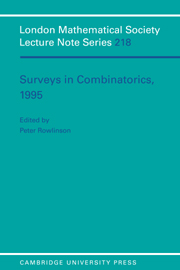Book contents
- Frontmatter
- Contents
- Preface
- Euclidean geometry of distance regular graphs
- Large sets of Steiner triples
- Searching with lies
- Spin models for link invariants
- Computational Pólya theory
- Mixing of random walks and other diffusions on a graph
- Cayley graphs: eigenvalues, expanders and random walks
- Construction and classification of combinatorial designs
- Modern probabilistic methods in combinatorics
Large sets of Steiner triples
Published online by Cambridge University Press: 05 May 2010
- Frontmatter
- Contents
- Preface
- Euclidean geometry of distance regular graphs
- Large sets of Steiner triples
- Searching with lies
- Spin models for link invariants
- Computational Pólya theory
- Mixing of random walks and other diffusions on a graph
- Cayley graphs: eigenvalues, expanders and random walks
- Construction and classification of combinatorial designs
- Modern probabilistic methods in combinatorics
Summary
INTRODUCTION
This year, 1995, is the centenary of the death of the Reverend Thomas Pennington Kirkman, Rector of Croft and Fellow of the Royal Society. In mathematical circles he is known, amongst other things, for his 1847 paper [Kl] in which he showed that Steiner triple systems of order v exist for all v ≡ 1 or 3 (mod 6). Since then, hundreds of papers have been written on many different aspects of such systems. Nevertheless, there are still fundamental but challenging questions which are unsolved. In this paper we consider just one of these concerned with the intersections of families of Steiner triple systems. We survey known results, present some recent advances, and pose a number of problems which suggest possible directions for future research in this area.
We start with some basic definitions. Recall that a Steiner triple system of order v (briefly STS(v)) is a pair (V, B) where V is a v-set, and B is a collection of 3-subsets of V called triples such that each 2-subset of V is contained in exactly one triple. A family (V,B1), …,(V,Bq) of q Steiner triple systems of order v, all on the same set V, is a large set of STS(v) if every 3-subset of V is contained in at least one STS of the collection. Two STS(v), (V,B1),(V,B2) are disjoint if B1 ∩ B2 = Ø, and almost disjoint if |B1 ∩ B2| = 1. Interest in families of disjoint STS also dates back to the last century: Cayley [C] determined that the maximum number of disjoint STS(7) is two and Sylvester [S] found a large set of 7 mutually disjoint STS(9).
- Type
- Chapter
- Information
- Surveys in Combinatorics, 1995 , pp. 25 - 40Publisher: Cambridge University PressPrint publication year: 1995
- 1
- Cited by



